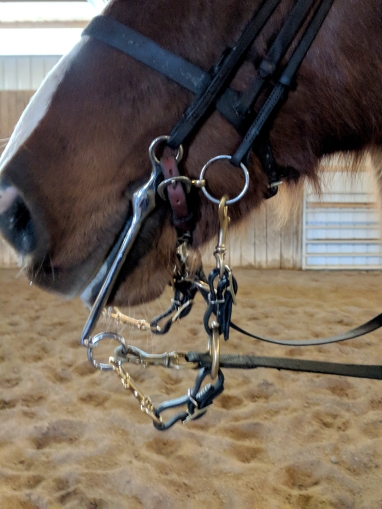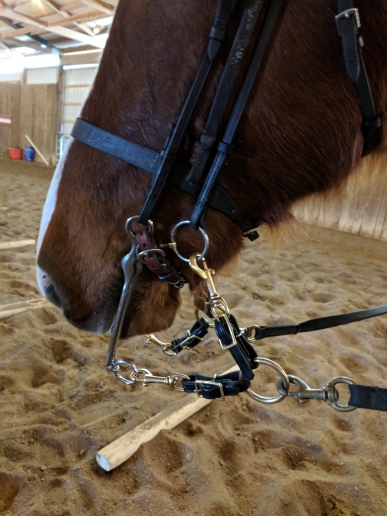When you’re an AOT, you should always, and I do mean ALWAYS be open to learning new things and to hearing others opinions and experiences. Not everything works for everyone, and not everything works for every horse. But having an arsenal of different things to try is definitely a good thing. I feel blessed to know a few trainers who are willing to help me when I have questions. This past weekend, I had the opportunity to go watch and learn from one of them. Trainer Blair Cecil of Phoenix Farms, my AOT hat goes off to you and your awesomeness!
The lesson? Bit converters. I confess, I bought a pair of these in August 2017 and I haven’t so much as snapped them to a single thing. Yes, that’s been 5 months ago. No, I’m not afraid to admit my lack of confidence on things I know nothing about. Hence why I started asking questions, to learn from others!
What is a Bit Converter? A bit converter is, as the name states, a contraption that “converts” two bits into one. It allows you to line/jog a horse in a full bridle (two bits) using just one set of lines, making 2 bits usable as one. The photo shows this on a short shank pelham bit, not a 2 bit weymouth style that we normally use in saddleseat, but the same general concept applies.

Why do this? My horse, like many others, is SO much happier when only ridden one, maybe two times a week. He loves to jog, which is terrific for his back end, building muscle, and conditioning. BUT, when you can only ride a few times a week, it’s difficult to log much time in a full bridle. Without wearing a full bridle often, it’s difficult to get them completely comfortable wearing it. As explained to me by Blair, using the converters in a lining/jogging situation is a lot more forgiving than riding. Here’s why: When you ride, there’s a lot more going on. Your seat, how you shift your weight, your leg aids, how good your hands are, how much you’re in or not in their mouth, how you hold two sets of reins, and what kind of pressure you put on each. Not to mention the stress on their backs from carrying a rider every single day on top of everything going on in their mouth. All of that is removed when you line/jog using these bit converters. The horse gets used to wearing the bits without all the stress from every day riding.
Equipment Needed: Surcingle (with or without crupper), martingale (optional), full bridle (use the bridle/bits your horse is used to wearing), long lines, and 1 set of bit converters. Oh, and if you use a lunge whip for lining, that too!
How to: I wish I would have taken pictures. When I attempt this with Fiz, I’ll definitely update. Until then, I’ll do the best I can to describe everything. So here goes. (NOW UPDATED WITH PICS!!! Yayyyyyyy!!!!)
Apply all the equipment as usual. Tie reins for the bridle in a knot and attach them to the top of the surcingle using string, a double ended snap, whatever you’ve got, so they don’t just flop all around and get tangled in the rest of the equipment. Or I guess you could remove them if you wanted to, your choice. To attach the bit converters, attach one snap to each bit on both sides of the bridle. Running your lines: Here’s where you’ll find there are different configuration options, which I never even thought of before visiting Blair! I promise to update with photos once it’s not so frozen outside and I can start working Fiz again!
- Run the lines through the converter ring and to the snaffle. This is where you should start with introducing your horse to the converter and lining in a full bridle. The curb will be in their mouth, but basically it’s just there, with no pressure on it.
 2. Run the lines through the converter and attach it to the curb. This puts pressure only on the curb bit. This seems better suited for a horse who is BROKE to the curb.
2. Run the lines through the converter and attach it to the curb. This puts pressure only on the curb bit. This seems better suited for a horse who is BROKE to the curb. 
- Run the lines and attach to the ring on the converter. This puts pressure on both bits.

- All of the above configurations can be done running the lines through a martingale or not using a martingale. It’s up to your preference and what you and your horse are used to using.
- Adjusting the converter: If you have purchased a set of bit converters, they should come with some kind of adjustment holes, so you can adjust how much pressure goes to each bit. Naturally, if you want even pressure, adjust them to the same length. If you want more pressure on the snaffle for example, loosen the end going to the curb. Proper adjustment for the horse you are working is the key to success.
Here’s a video of me lining Fizzy in the first configuration.
Fizzy Long Lining – Full Bridle